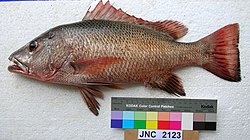Mangrove red snapper
| Mangrove red snapper | |
|---|---|
 |
|
| Lutjanus argentimaculatus from New Caledonia | |
|
Not evaluated (IUCN 3.1)
|
|
| Scientific classification | |
| Kingdom: | Animalia |
| Phylum: | Chordata |
| Class: | Actinopterygii |
| Order: | Perciformes |
| Family: | Lutjanidae |
| Genus: | Lutjanus |
| Species: | L. argentimaculatus |
| Binomial name | |
|
Lutjanus argentimaculatus (Forsskål, 1775) |
|
| Synonyms | |
|
|
The Mangrove red snapper (commonly called mangrove jack within Australia), Lutjanus argentimaculatus is a species of snapper. It is also known as creek red bream, the Stuart evader, dog bream, mangrove red snapper, purple sea perch, purple sea-perch, red bass, red bream, red perch, red reef bream, river roman or rock barramundi.
The Mangrove red snapper is native to the Indian Ocean and the western Pacific Ocean from the African coast to Samoa and the Line Islands and from the Ryukyus in the north to Australia in the south. It has also been recorded from the coast of Lebanon in the Mediterranean Sea having reached there from the Red Sea through the Suez Canal, though it is not established in the Mediterranean.
Coloration of the mangrove red snapper ranges from burnt orange, to copper, to bronze and dark reddish-brown, depending on its age and environment. Younger fish caught in estuarine areas are often darker than older fish taken from offshore reef areas, and exhibit lighter vertical bands down their flanks.
Like other tropical snappers (family Lutjanidae), Mangrove Jacks have prominent canine teeth in their jaws that are used for seizing and holding prey. These teeth can cause a nasty injury to unwary fishers.
In reef areas, mangrove red snappers are sometimes confused with two-spot red snapper or red bass (Lutjanus bohar), a known carrier of ciguatera toxin. The red bass, however, is usually darker in coloration, has fewer dorsal-fin spines, scale rows on the back that rise obliquely from the lateral line, and a deep groove from the nostrils to the eyes.
The species is carnivorous: they are predators, feeding mainly at night on fishes, crustaceans, gastropods and cephalopod molluscs. As ambush predators, they often dwell around mangrove roots, fallen trees, rock walls, and any other snag areas where smaller prey reside for protection.
...
Wikipedia
